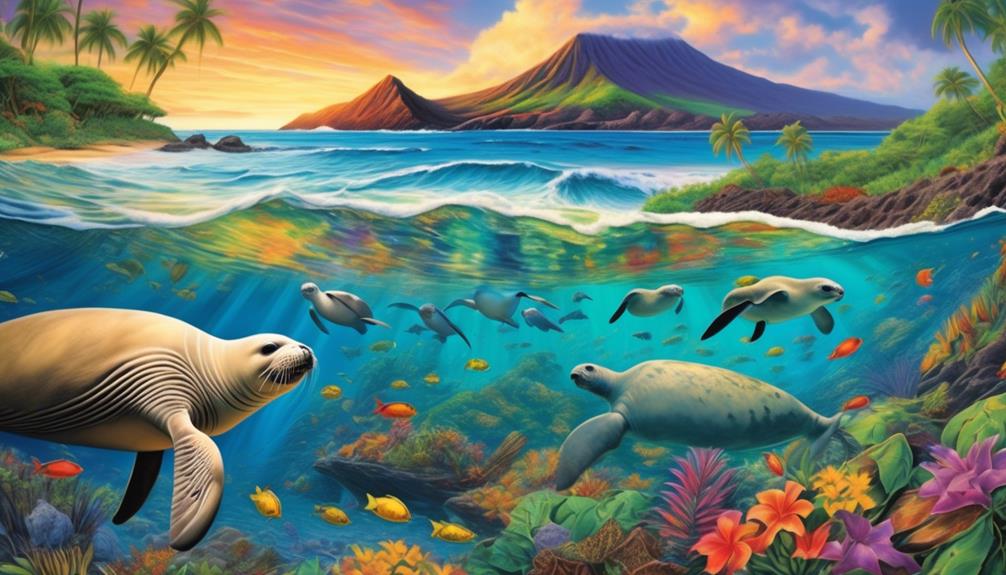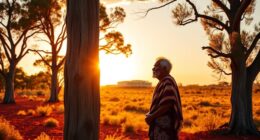Are you familiar with the Hawaiian Monk Seal, a species that is native to Hawaii and currently at risk of extinction?
When it comes to the native animals of Hawaii, there's a fascinating array of species that have evolved in isolation over thousands of years. These unique creatures have adapted to the islands' diverse ecosystems, but there's a lot more to learn about the indigenous wildlife of Hawaii.
Key Takeaways
- Hawaiian Honeycreeper Birds and Nene (Hawaiian Goose) exhibit remarkable diversity of colors and beak shapes, allowing them to exploit various food sources.
- The Hawaiian Monk Seal and Hawaiian Hoary Bat are critically endangered species in Hawaii, with conservation efforts focusing on habitat restoration and breeding programs.
- The Hawaiian Green Sea Turtle is an iconic symbol of Hawaii's marine life, and the conservation of nesting sites is crucial for their survival.
- The conservation efforts for all these indigenous animals in Hawaii include protecting native habitats, implementing captive breeding programs, and understanding migration patterns for successful coexistence with human activities.
Hawaiian Honeycreeper Birds
Hawaiian Honeycreeper Birds display a remarkable diversity of colors and beak shapes, making them a unique and captivating group of avian species. Evolutionary adaptations have led to their specialized beaks, allowing them to exploit various food sources such as nectar, fruit, and insects. This diversity is a result of adaptive radiation, where a common ancestor diversified into multiple species to exploit different ecological niches across the Hawaiian archipelago.
Conservation efforts are crucial for the survival of these birds, as many species are endangered due to habitat destruction, disease, and invasive species. Protecting their native habitats and controlling the spread of non-native predators and diseases are essential for the preservation of these iconic birds. Additionally, captive breeding and reintroduction programs are being implemented to bolster dwindling populations and ensure their long-term survival.
Understanding the evolutionary history and ecological requirements of Hawaiian Honeycreeper Birds is essential for implementing effective conservation strategies. By protecting these unique birds and their habitats, we can ensure the continued existence of this extraordinary example of adaptive radiation in the avian world.
Endangered Hawaiian Monk Seal

The diverse array of native species in Hawaii faces various threats, and among them, the Endangered Hawaiian Monk Seal stands as a poignant example of the pressing conservation challenges in the region.
With a population of only about 1,400 individuals, this species is critically endangered due to human impact, including entanglement in marine debris, habitat destruction, and disturbance on beaches.
Conservation efforts are underway to protect and restore the habitat of the Hawaiian Monk Seal. Habitat restoration projects aim to create safe spaces for the seals to rest, molt, and raise their pups. Breeding programs are also being implemented to bolster the population of this unique marine mammal.
These programs involve monitoring the health and reproductive success of the seals, as well as mitigating human disturbances in their breeding areas.
The combination of these efforts is crucial for the survival of the Hawaiian Monk Seal, ensuring that future generations will continue to marvel at this remarkable marine species in its natural habitat.
Hawaiian Green Sea Turtle
Once abundant throughout the waters of the Pacific, the Hawaiian Green Sea Turtle, also known as the honu, has become an iconic symbol of the islands' marine life. These magnificent creatures can be found gracefully gliding through the crystal-clear waters, showcasing their vibrant green and brown shells. As we delve into the world of the Hawaiian Green Sea Turtle, we uncover the marvels of its existence.
- Habitat Conservation: The conservation of the Hawaiian Green Sea Turtle's habitat is crucial for their survival. Efforts to protect their nesting sites, such as the beaches along the coastlines of Hawaii, are paramount in ensuring the continuation of their species.
- Migration Patterns: These sea turtles exhibit remarkable migration patterns, often traveling long distances between foraging and nesting areas. Understanding and preserving these migration routes are vital for their well-being.
- Feeding Habits: Hawaiian Green Sea Turtles are primarily herbivores, feasting on seaweed and algae. Their feeding habits play a significant role in maintaining the delicate balance of the marine ecosystem.
Studying the Hawaiian Green Sea Turtle enriches our understanding of the intricate web of life within the Hawaiian marine environment.
Nene (Hawaiian Goose)

Gracefully gliding through the lush landscapes of Hawaii, the Nene exhibits a remarkable adaptation to its island habitat. As the state bird of Hawaii, this endangered species has faced numerous challenges, making conservation efforts and breeding programs crucial for its survival. The Nene, or Hawaiian Goose, is known for its unique migration patterns and specific habitat requirements. It primarily inhabits grasslands, shrublands, and coastal areas, displaying a remarkable ability to thrive in the diverse environments of the Hawaiian Islands.
| Habitat | Diet | Physical Characteristics |
|---|---|---|
| Grasslands | Grasses, seeds | Mottled brown plumage, |
| Shrublands | Fruits, insects | Black face, buff-colored |
| Coastal areas | cheeks, and neck |
Conservation efforts have focused on habitat restoration and protection, as well as the establishment of breeding programs to increase the Nene population. These programs aim to safeguard the genetic diversity of the species while working to reintroduce them into suitable habitats. Understanding the migration patterns of the Nene is crucial for conservationists to ensure the successful coexistence of this iconic Hawaiian bird with human activities and development.
Hawaiian Hoary Bat
With the Nene's habitat conservation efforts in mind, the Hawaiian Hoary Bat emerges as another unique and vital indigenous animal of Hawaii, showcasing its own impressive adaptations and ecological significance.
The Hawaiian Hoary Bat, also known as 'Ope'ape'a, is the only native land mammal in Hawaii and plays a crucial role in the island's ecosystem.
- Habitat Preservation: The Hawaiian Hoary Bat is highly dependent on specific roosting habitats, such as trees and caves, making habitat preservation essential for their survival. Protecting these roosting sites is crucial for maintaining healthy bat populations.
- Conservation Efforts: Due to threats like habitat loss and disturbance, conservation efforts are focused on preserving the bat's natural habitat, raising awareness among the public, and implementing measures to minimize human disturbances.
- Ecological Significance: As nocturnal insectivores, these bats contribute to controlling insect populations, which is vital for maintaining the balance of the ecosystem. By consuming insects, they help regulate pest populations, benefiting agriculture and the overall environment.
Understanding and protecting the Hawaiian Hoary Bat is pivotal for the preservation of Hawaii's natural heritage.
Frequently Asked Questions
What Is the Historical Significance of These Indigenous Animals to Hawaiian Culture and Traditions?
Historical significance of indigenous animals to Hawaiian culture and traditions is profound. These creatures are central to traditional stories and hold deep spiritual and symbolic meanings.
Their presence in the ecosystem shapes cultural practices and conservation efforts. For example, the honu (green sea turtle) is revered as a symbol of longevity and wisdom, playing a vital role in Hawaiian mythology.
Understanding these connections is crucial for preserving the rich cultural heritage and biodiversity of Hawaii.
How Has Human Activity and Development Affected the Habitats and Populations of These Indigenous Animals?
Human activity, particularly tourism and urbanization, has profoundly impacted the habitats and populations of indigenous animals in Hawaii. These activities have caused habitat destruction, fragmentation, and degradation, leading to the decline of many species.
Tourism has brought increased development and disturbance to natural areas, while urbanization has encroached on wildlife habitats. These changes have disrupted ecosystems, threatening the survival of indigenous animals and challenging conservation efforts.
Are There Any Conservation Efforts or Organizations Dedicated to Protecting These Indigenous Animals in Hawaii?
Conservation efforts in Hawaii are crucial for protecting endangered species and preserving wildlife.
Community involvement plays a key role in these initiatives, with organizations dedicated to wildlife protection leading the way.
These efforts focus on restoring habitats, implementing breeding programs, and raising awareness about the unique indigenous animals of Hawaii.
Through collaborative action, we aim to safeguard the rich biodiversity of the islands for future generations.
What Are the Main Threats Facing These Indigenous Animals and What Is Being Done to Mitigate Those Threats?
Mitigating threats to indigenous animals in Hawaii is crucial for their survival. Human impact, such as habitat destruction and invasive species, poses significant challenges.
Conservation efforts focus on population decline reversal, habitat restoration, and predator control. These actions help protect species like the Hawaiian monk seal and the Hawaiian hoary bat.
Through collaborative efforts, we strive to secure the future of these unique and precious animals.
Are There Any Traditional Stories or Legends in Hawaiian Culture That Feature These Indigenous Animals?
Traditional stories and legends in Hawaiian culture hold a deep reverence for indigenous animals. These tales often highlight the cultural significance and folklore of these creatures, weaving them into the fabric of Hawaiian traditions.
From the majestic honu (green sea turtle) to the graceful nene (Hawaiian goose), these indigenous animals play pivotal roles in the rich narrative of Hawaiian folklore, serving as symbols of resilience, wisdom, and harmony with the natural world.
Conclusion
In conclusion, Hawaii is home to a unique and diverse range of indigenous animals, many of which are found nowhere else in the world.
The Hawaiian Honeycreeper Birds, for example, once boasted over 50 species, but now only a fraction remain due to habitat loss and invasive species.
This decline serves as a sobering reminder of the importance of conservation efforts to protect the rich biodiversity of the Hawaiian islands.









